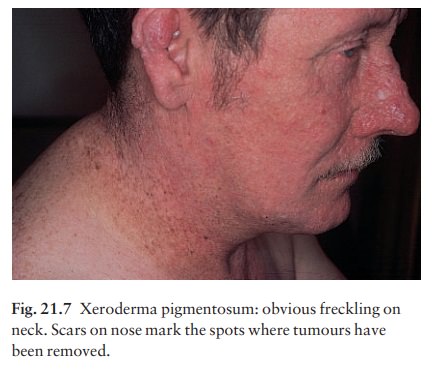Chapter: Clinical Dermatology: Other genetic disorders
Xeroderma pigmentosum
Xeroderma
pigmentosum
Xeroderma
pigmentosum is a heterogeneous group of autosomal recessive disorders,
characterized by the defective repair of DNA after its damage by ultra-violet
radiation. The condition is rare affecting about 5 per million in Europe.
Cause
Ultraviolet
light damages DNA by producing covalent linkages between adjacent pyrimidines.
These distort the double helix and inhibit gene expression. Cells from
xeroderma pigmentosum patients lack the abil-ity of normal cells to repair this
damage.
DNA
repair is a complex process using a large number of genes that encode a variety
of interacting products that locate and prepare damaged sites for excision and
replacement. It is not surprising there-fore that many genetic defects can lead
to a similar clinical picture. The genes for seven main types of xeroderma
pigmentosum have now been identified.
Clinical features
There are many variants but all follow the same pattern.
• The skin is normal at birth.
•
Multiple freckles, roughness and
keratoses on exposed skin appear between the ages of 6 months and 2 years (Fig.
21.7). Photosensitivity increases thereafter.

•
The atrophic facial skin shows
telangiectases and small angiomas.
•
Many tumours develop on
light-damaged skin: these include basal cell carcinomas, squamous cell
carcino-mas, keratoacanthomas and malignant melanomas. Many patients die before
the age of 20 years.
•
Eye problems are common and include
photopho-bia, conjunctivitis and ectropion.
•
The condition may be associated with
microcephaly, mental deficiency, dwarfism, deafness and ataxia (De
Sanctis–Cacchione syndrome).
Diagnosis
This
becomes evident on clinical grounds, although variants with minor signs may
cause difficulty. The DNA repair defect can be detected in a few laborator-ies
after the ultraviolet irradiation of cultured fibrob-lasts or lymphocytes from
the patient.
Treatment
Skin
cancers can be prevented by strict avoidance of sunlight, the use of protective
clothing, wide-brimmed hats and of reflectant sunscreens and dark glasses. If
possible, patients should not go out by day. Early and complete removal of all
tumours is essential. Radio-therapy should be avoided.
Related Topics